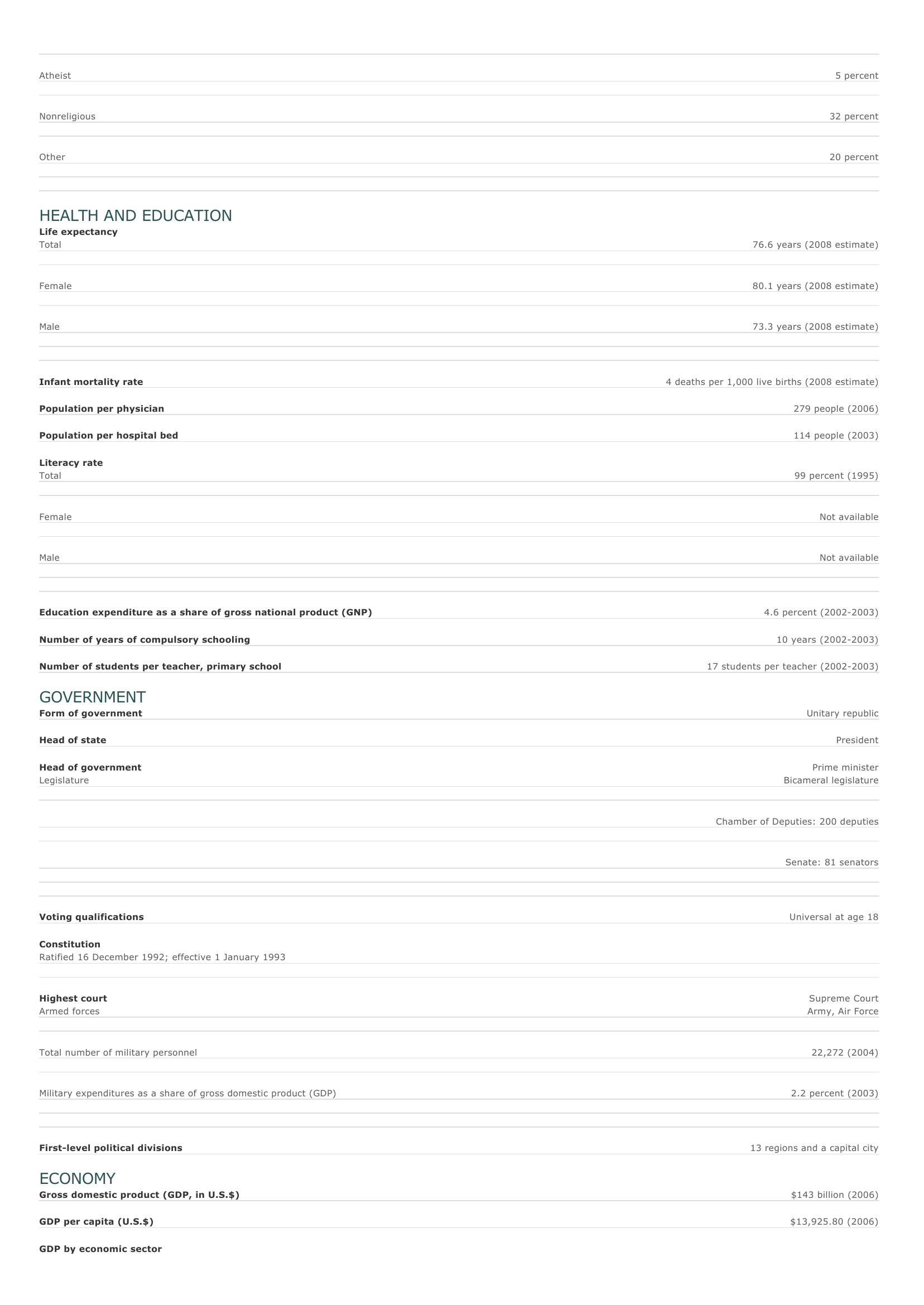Czech Republic Facts and Figures. BASIC FACTS Official name Capital Area Czech Republic Prague 78,864 sq km 30,450 sq mi PEOPLE Population 10,220,911 (2008 estimate) Population growth Population growth rate -0.08 percent (2008 estimate) Projected population in 2025 9,844,275 (2025 estimate) Projected population in 2050 8,540,221 (2050 estimate) Population density 132 persons per sq km (2008 estimate) 343 persons per sq mi (2008 estimate) Urban/rural distribution Share urban 75 percent (2005 estimate) Share rural 25 percent (2005 estimate) Largest cities, with population Prague 1,170,000 (2003 estimate) Brno 376,172 (2003 estimate) Ostrava 316,744 (2003 estimate) Plze? 165,259 (2003 estimate) Olomouc 102,607 (2003 estimate) Ethnic groups Czech 94.0 percent Slovak 3.0 percent Roma (Gypsy) 0.7 percent Polish 0.6 percent G erman 0.5 percent Hungarian 0.2 percent O ther 1.0 percent Languages Czech (official), Slovak, German, Russian, English Religious affiliations Roman Catholic Protestant 40 percent 3 percent Atheist 5 percent Nonreligious 32 percent O ther 20 percent HEALTH AND EDUCATION Life expectancy Total 76.6 years (2008 estimate) Female 80.1 years (2008 estimate) Male 73.3 years (2008 estimate) Infant mortality rate 4 deaths per 1,000 live births (2008 estimate) Population per physician 279 people (2006) Population per hospital bed 114 people (2003) Literacy rate Total 99 percent (1995) Female Not available Male Not available Education expenditure as a share of gross national product (GNP) Number of years of compulsory schooling Number of students per teacher, primary school 4.6 percent (2002-2003) 10 years (2002-2003) 17 students per teacher (2002-2003) GOVERNMENT Form of government Head of state Head of government Legislature Unitary republic President Prime minister Bicameral legislature Chamber of Deputies: 200 deputies Senate: 81 senators Voting qualifications Universal at age 18 Constitution Ratified 16 December 1992; effective 1 January 1993 Highest court Armed forces Total number of military personnel Military expenditures as a share of gross domestic product (GDP) First-level political divisions Supreme Court Army, Air Force 22,272 (2004) 2.2 percent (2003) 13 regions and a capital city ECONOMY Gross domestic product (GDP, in U.S.$) $143 billion (2006) GDP per capita (U.S.$) $13,925.80 (2006) GDP by economic sector Agriculture, forestry, fishing 2.7 percent (2006) I ndustry 39 percent (2006) Services 58.3 percent (2006) Employment Number of workers 5,218,399 (2006) Workforce share of economic sector Agriculture, forestry, fishing 4 percent (2005) I ndustry 40 percent (2005) Services 57 percent (2005) Unemployment rate 8.3 percent (2004) National budget (U.S.$) Total revenue $43,753 million (2006) Total expenditure $50,704 million (2006) Monetary unit 1 Czech koruna (Kc), consisting of 100 haleru Agriculture Barley, wheat, corn, rye, sugar beets, potatoes, flax, hops, livestock, timber Mining Brown coal, hard coal, petroleum, uranium, other minerals Manufacturing Woven fabrics, paper, crude steel, pig iron, footwear, food products, alcoholic beverages Major exports Coal, machinery, steel, automobiles, footwear, rolling stock, iron Major imports Energy and raw materials, machinery, automobiles, iron and other ores, telecommunications equipment, pharmaceuticals Major trade partners for exports Germany, Slovakia, Austria, United Kingdom, and Poland Major trade partners for imports Germany, Russia, Slovakia, Italy, and France ENERGY, COMMUNICATIONS, AND TRANSPORTATION Electricity production Electricity from thermal sources Electricity from hydroelectric sources Electricity from nuclear sources Electricity from geothermal, solar, and wind sources 65.94 percent (2003 estimate) 1.75 percent (2003 estimate) 31.44 percent (2003 estimate) 0.87 percent (2003 estimate) Number of radios per 1,000 people 803 (1997) Number of telephones per 1,000 people 314 (2005) Number of televisions per 1,000 people 506 (2000 estimate) Number of Internet hosts per 10,000 people 274 (2003) Daily newspaper circulation per 1,000 people 256 (1996) Number of motor vehicles per 1,000 people 391 (2002) Paved road as a share of total roads 100 percent (2003) SOURCES Basic Facts and People sections Area data are from the statistical bureaus of individual countries. Population, population growth rate, and population projections are from the United States Census Bureau, International Programs Center, International Data Base (IDB) (www.census.gov). Urban and rural population data are from the Food and Agriculture Organization (FAO) of the United Nations (UN), FAOSTAT database (www.fao.org). Largest cities population data and political divisions data are from the statistical bureaus of individual countries. Ethnic divisions and religion data are largely from the latest Central Intelligence Agency (CIA) World Factbook and from various country censuses and reports. Language data are largely from the Ethnologue, Languages of the World, Summer Institute of Linguistics International (www.sil.org). Health and Education section Life expectancy and infant mortality data are from the United States Census Bureau, International Programs Center, International database (IDB) (www.census.gov). Population per physician and population per hospital bed data are from the World Health Organization (WHO) (www.who.int). Education data are from the United Nations Educational, Scientific and Cultural Organization (UNESCO) database (www.unesco.org). Government section Government, independence, legislature, constitution, highest court, and voting qualifications data are largely from various government Web sites, the latest Europa World Yearbook, and the latest Central Intelligence Agency (CIA) World Factbook. The armed forces data is from Military Balance. Economy section Gross domestic product (GDP), GDP per capita, GDP by economic sectors, employment, and national budget data are from the World Bank database (www.worldbank.org). Monetary unit, agriculture, mining, manufacturing, exports, imports, and major trade partner information is from the statistical bureaus of individual countries, latest Europa World Yearbook, and various United Nations and International Monetary Fund (IMF) publications. Energy, Communication, and Transportation section Electricity information is from the Energy Information Administration (EIA) database (www.eia.doe.gov). Radio, telephone, television, and newspaper information is from the United Nations Educational, Scientific and Cultural Organization (UNESCO) database (www.unesco.org). Internet hosts, motor vehicles, and road data are from the World Bank database (www.worldbank.org). Note Figures may not total 100 percent due to rounding. Microsoft ® Encarta ® 2009. © 1993-2008 Microsoft Corporation. All rights reserved.






